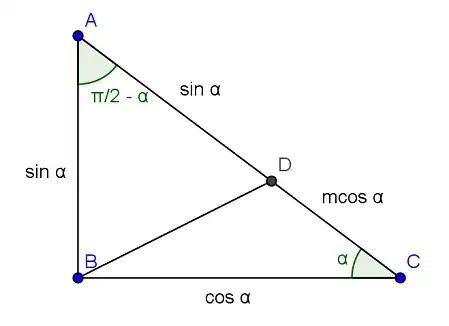Because you're familiar with complex exponentials, all you needed to succeed is to observe that by setting $w = m - i$ your equation becomes
$$w \exp(i \alpha) + \bar{w} \exp(-i \alpha) = 2.$$
(Edit What might motivate this choice of $w$? Well, if you're thinking of complex numbers you're thinking that $\cos(\alpha) + i \sin(\alpha) = \exp(i \alpha)$. To obtain $m \cos(\alpha) + \sin(\alpha)$ from this you need to multiply $\cos(\alpha)$ by $m$ and $i \sin(\alpha)$ by $-i$. Thus it's automatic to set out by computing
$$(m - i)(\cos(\alpha) + i \sin(\alpha)) = \left(m \cos(\alpha) + \sin(\alpha)\right) + \left(\text{real stuff}\right) i.$$
The real part of this expression is exactly what you need, whence the original equation reads
$$1 = \mathbb{Re}\left(w \exp(i \alpha))\right) = \frac{w \exp(i \alpha) + \overline{w \exp(i \alpha)}}{2} = \frac{w \exp(i \alpha) + \bar{w} \exp(-i \alpha)}{2}.$$
Multiply by 2 to clear the fraction. End of edit)
Setting $z = \exp(i \alpha)$ to simplify the notation yields
$$w z^2 - 2 z + \bar{w} = 0,$$
with two generic solutions by the quadratic formula:
$$z = \frac{1 + \sqrt{1 - |w|^2}}{w}, \quad z = \frac{1 - \sqrt{1 - |w|^2}}{w}.$$
Because $\sqrt{1 - |w|^2} = \pm m i$, the solutions simplify to
$$z = \frac{i + m}{1 + m i}, \quad z = i.$$
(Once again we see a connection to fractional linear transformations, as per @Qiaochu Yuan's comment.)
By definition, $\alpha$ is the argument (polar coordinate) of a solution $z$. Writing $\tan(\theta) = m$ (which defines $\theta$ up to an integral multiple of $\pi$), the argument of the denominator is $\theta$ while the argument of the numerator is equal to $\pi/2 - \theta$. Whence
$$\alpha = \pi/2 - 2\theta \quad \text{or} \quad \alpha = \pi/2$$
(both modulo an integral multiple of $2 \pi$).
If you prefer, in the first case you may write
$$\alpha = \pi/2 - 2\arctan(m).$$
The second case obviously gives the trivial solutions $1 = m \cos(\pi/2 + 2 n \pi) + \sin(\pi/2 + 2 n \pi)$ $= m 0 + 1.$
The first solution appears to be a new one, but it's equivalent to the others that have been obtained. As a check, we may assume $\theta$ is not an odd multiple of $\pi/2$, whence $\alpha$ is not an odd multiple of $\pi/2$, and compute
$$m \cos(\alpha) + \sin(\alpha)$$
$$ = \tan(\theta) \cos(\pi/2 - 2 \theta) + \sin(\pi/2 - 2\theta) = \tan(\theta) \sin(2 \theta) + \cos(2 \theta)$$
$$= \frac{\sin(\theta)}{\cos(\theta)}\left(2 \sin(\theta) \cos(\theta)\right) + \left(\cos(\theta)^2 - \sin(\theta)^2\right)$$
$$= \sin(\theta)^2 + \cos(\theta)^2 = 1.$$
Although for a problem like this I would ordinarily take the route described by @Robin Chapman, I like this complex number approach because it produces a simpler solution (which actually is defined for $m = -1$, btw) by means of straightforward techniques and it explicitly produces all solutions. When $m \lt -1$ and we use the standard branch of the arctangent it differs by $2 \pi$ from the one Mathematica obtained, but that's of no consequence. (It's curious that Mathematica cannot tell these two solutions are the same, even when you restrict the domain to real nonnegative $m$. A plot of their difference will remove any lingering doubts.)


$\cos \alpha =\cos ^{2}\frac{\alpha }{2}-\sin ^{2}\frac{\alpha }{2}$ $=\frac{% \cos ^{2}\frac{\alpha }{2}-\sin ^{2}\frac{\alpha }{2}}{\cos ^{2}\frac{\alpha }{2}+\sin ^{2}\frac{\alpha }{2}}$ $=\frac{1-\tan ^{2}\frac{\alpha }{2}}{1+\tan ^{2}\frac{\alpha }{2}}$.
– Américo Tavares Nov 06 '10 at 18:42